Test Case of Elasto-Magnetism in Stationary and Axisymmetrical Case
1. Introduction
This page presents the simulation and result of page Elastic Equations with Electromagnetism and Thermic in Axisymmetrical case : Elastic, Thermic and Electromagnetism problem coupled by Thermal Dilatation in stationnary and axisymmetrical case.
2. Run the calculation
The command line to run this case is :
mpirun -np 16 feelpp_toolbox_coefficientformpdes --config-file=elasto-thermo-mag.cfg --cfpdes.gmsh.hsize=5e-3
To compute with only the Thermal Dilatation, please, put :
"bool_laplace":0,
"bool_dilatation":1,
On Parameter function of .json file elasto-thermo-mag.json.
3. Data Files
The case data files are available in Github here :
-
CFG file - Edit the file
-
JSON file - Edit the file
-
GEO file - Edit the file
4. Equation
In this subsection, we couple the equation (Static Elasticity Axis) of Elastic equation and (AV Axis) AV-Formulation in axisymmetrical coordinates.
The domain of resolution of electromagnetism part is \(\Omega^{axis}\) with bounds \(\Gamma^{axis}\), \(\Gamma_D^{axis}\) the bound of Dirichlet conditions and \(\Gamma_N^{axis}\) the bound of Neumann conditions such that \(\Gamma^{axis} = \Gamma_N^{axis} \cup \Gamma_D^{axis}\).
The domain of resolution of elastic part is \(\Omega_c^{axis} \subset \Omega^{axis}\) (and the domain of definition of electrical potential \(V\) and electrical conductivity \(\sigma\)) with bounds \(\Gamma_c^{axis}\), \(\Gamma_{D \hspace{0.05cm} elas}^{axis}\) the bound of Dirichlet conditions and \(\Gamma_{N \hspace{0.05cm} elas}^{axis}\) the bound of Neumann conditions such that \(\Gamma_c^{axis} = \Gamma_{D \hspace{0.05cm} elas}^{axis} \cup \Gamma_{N \hspace{0.05cm} elas}^{axis}\). The domain \(\Omega_c^{axis}\) correspond to the conductor.
With :
|
|
|
|
|
|
And notations :
-
Divergence of tensor : \(\nabla \cdot \bar{\bar{\sigma}} = \begin{pmatrix} \nabla \cdot \bar{\bar{\sigma}}_{r,:} + \frac{\bar{\bar{\sigma}}_{rr} - \bar{\bar{\sigma}}_{\theta \theta}}{r} \\ \nabla \cdot \bar{\bar{\sigma}}_{z,:} + \frac{\bar{\bar{\sigma}}_{rz}}{r} \end{pmatrix}\)
-
Scalar produce of tensor : \(\bar{\bar{\sigma}} \cdot \mathbf{n} = \begin{pmatrix} \bar{\bar{\sigma}}_{r,:} \cdot \mathbf{n}^{axis} \\ \bar{\bar{\sigma}}_{z,:} \cdot \mathbf{n}^{axis} \end{pmatrix} = \begin{pmatrix} \bar{\bar{\sigma}}_{rr} \, n_r + \bar{\bar{\sigma}}_{rz} \, n_z \\ \bar{\bar{\sigma}}_{zr} \, n_r + \bar{\bar{\sigma}}_{zz} \, n_z\end{pmatrix}\)
| The equation become coupled in one senses, the second equation (Elas-1 Axis) depends of potentials. |
| We don’t care of geometrical deformation which can change the mesh or the density. We suppose the geometry is fixed. |
5. Geometry
The geometry is a torus of the conductor in cartesian coordinates \((x,y,z)\) or rectangle in axisymmetric coordinates \((r,z)\), surrounded by air.
.png)
Geometry in axisymmetrical cut loop on Conductor
|
.png)
Geometry in axisymmetrical cut
|
.png)
Geometry in three dimensions
|
.png)
Geometry in three dimensions cut loop on Conductor
|
The geometrical domains are :
-
Conductor: the torus is composed by conductor material-
Interior: interior surface of conductor ring -
Exterior: exterior surface of conductor ring -
Upper: upper of conductor ring -
Bottom: bottom of conductor ring
-
-
Air: the air surroundConductor-
zAxis: a bound ofAir, correspond to \(Oz\) axis (\(\{(z,r), \, z=0 \}\)) -
infty: the rest of bound ofAir
-
Symbol |
Description |
value |
unit |
\(r_{int}\) |
interior radius of torus |
\(75e-3\) |
m |
\(r_{ext}\) |
exterior radius of torus |
\(100.2e-3\) |
m |
\(z_1\) |
half-height of torus |
\(300e-3\) |
m |
\(r_{infty}\) |
radius of infty border |
\(5*r_{ext}\) |
m |
6. Boundary Conditions
We impose the boundary conditions :
-
Magnetic Equation :
-
Strong Dirichlet :
-
On
zAxis: \(\Phi = 0\) (\(A_{\theta} = 0\) by symetric argument) -
On
infty: \(\Phi = 0\) (\(A_{\theta} = 0\) we consider the bound of resolution like infty for magnetic field)
-
-
-
Heat Equation :
-
Neumann : \(\frac{\partial T}{\partial \mathbf{n}} = 0\) on
InteriorandExterior -
Robin : \(-k \, \frac{\partial T}{\partial \mathbf{n}} = h \, \left( T - T_c \right)\) on
UpperandBottom. The Robin condition represents the cooling by water.
-
-
Elastic Equation :
-
Strong Dirichlet : \(\mathbf{u} = 0\) on
UpperandBottom. The Dirichlet condition represents the embedding of mechanical part. -
Neumann : \(\bar{\bar{\sigma}} \cdot \mathbf{n} = 0\) on
InteriorandExterior. The Neumann condition represents the freedom of displacement.
-
On JSON file, the boundary conditions are writed :
"BoundaryConditions":
{
"magnetic":
{
"Dirichlet":
{
"magdir":
{
"markers":["ZAxis","Infty"],
"expr":"0"
}
}
},
"heat":
{
"Robin":
{
"heatdir":
{
"markers":["Interior","Exterior"],
"expr1":"h*x:h:x",
"expr2":"h*T_c*x:h:T_c:x"
}
}
},
"elastic":
{
"Dirichlet":
{
"elasdir":
{
"markers":["Upper","Bottom"],
"expr":"{0,0}"
}
}
}
}
7. Weak Formulation
We obtain :
8. Parameters
The parameters of problem are :
-
On
Conductor:
Symbol |
Description |
Value |
Unit |
\(V\) |
scalar electrical potential |
\( U \, \frac{\theta}{2\pi}\) |
\(Volt\) |
\(U\) |
electrical potential |
\(0.2\) |
\(Volt\) |
\(\sigma\) |
electrical conductivity at \(T=T_0\) |
\(58e6\) |
\(S/m\) |
\(j_{\theta}\) |
orthoradial current density |
\(- \sigma \frac{U}{2\pi} \, \frac{1}{r}\) |
\(A/m^2\) |
\(E\) |
Young Modulus |
\(2.1e6\) |
\(Pa\) |
\(v\) |
Poisson’s coefficient |
\(0.33\) |
\(dimensionless\) |
\(\lambda\) |
Lame’s coefficient |
\(\frac{E \, v}{(1-2v)(1+v)}\) |
\(Pa\) |
\(\mu\) |
Lame’s coefficient |
\(\frac{E}{2 (1+v)}\) |
\(Pa\) |
-
On
Air:
Symbol |
Description |
Value |
Unit |
\(\mu=\mu_0\) |
magnetic permeability of vacuum |
\(4\pi.10^{-7}\) |
\(kg \, m / A^2 / S^2\) |
On JSON file, the parmeters are writed :
"Parameters":
{
"bool_laplace":0,
"bool_dilatation":1,
"h":80000, // W/m2/K
"T_c":293, // K
"T0":293, // K
// Constants of analytical solve
"a":77.32, // K
"b":0.40041, // K
"rmax":0.0861910719118454, // m
"Tmax":295.85 // K
}
9. Coefficient Form PDEs
We use the application Coefficient Form PDEs. The coefficient associate to Weak Formulation are :
-
For MQS equation (Weak MQS Axis) :
-
On
Conductor:
Coefficient
Description
Expression
\(d\)
damping or mass coefficient
\(\sigma\)
\(c\)
diffusion coefficient
\(\frac{r}{\mu}\)
\(\beta\)
convection coefficient
\(\begin{pmatrix} \frac{2}{\mu} \\ 0 \end{pmatrix}\)
\(f\)
source term
\(j_{\theta} \, r^2\)
-
On
Air:
Coefficient
Description
Expression
\(c\)
diffusion coefficient
\(\frac{r}{\mu}\)
-
-
For heat equation, on
Conductor(the temperature isn’t computed onAir)
Coefficient |
Description |
Expression |
\(d\) |
damping or mass coefficient |
\(\rho \, C_p\) |
\(c\) |
diffusion coefficient |
\(k\) |
\(f\) |
source term |
\(- \sigma \left( \frac{U}{2\pi \, r} \right)^2\) |
-
For elastic equation, on
Conductor(the displacement isn’t computed onAir) :Coefficient
Description
Expression
\(c\)
diffusion coefficient
\(r \mu\)
\(\gamma\)
conservative flux source term
\(\begin{pmatrix} - \lambda \left( r \frac{\partial u_r}{\partial r} + u_r + r \frac{\partial u_z}{\partial z} \right) - \mu \, r \, \frac{\partial u_r}{\partial r} - r \sigma_T & - \mu \, r \, \frac{\partial u_z}{\partial r} \\ - \mu \, r \, \frac{\partial u_r}{\partial z} & - \lambda \left( r \, \frac{\partial u_r}{\partial r} + u_r + r \, \frac{\partial u_z}{\partial z} \right) - \mu \, r \, \frac{\partial u_z}{\partial z} - r \sigma_T \end{pmatrix}\)
\(f\)
source term
\(\begin{pmatrix} r F_r - \lambda \frac{\partial u_r}{\partial r} - (\lambda+2\mu) \frac{u_r}{r} - \lambda \frac{\partial u_z}{\partial z} - \sigma_T \\ r F_z \end{pmatrix}\)
On JSON file, the coefficients are writed :
"Materials":
{
"Conductor":
{
// Magnetic Part
"U":0.2, // Volt
"sigma":58e+6, // S.m-1
"mu":"4*pi*1e-7", // kg.m/A2/S2
"j_th":"-sigma*U/2/pi/x:sigma:U:x",
"magnetic_c":"x/mu:x:mu",
"magnetic_beta":"{2/mu,0}:mu",
"magnetic_f":"-sigma*U/2/pi*x:sigma:U:x",
// Heat Part
"k":380, // W/m/K
"heat_c":"k*x:k:x",
"heat_f":"sigma*U/(2*pi)*U/(2*pi)/x:sigma:U:x",
// Elastic Part
"E":2.1e6, // Pa
"v":0.33, // dimensionless
"alpha_T":"17e-6", // K-1
"Lame_lambda":"E*v/(1-2*v)/(1+v):E:v",
"Lame_mu":"E/(2*(1+v)):E:v",
"F_laplace":"{1/x*j_th*magnetic_grad_phi_0, 1/x*j_th*magnetic_grad_phi_1}::x:j_th:magnetic_grad_phi_0:magnetic_grad_phi_0:magnetic_grad_phi_1",
"sigma_T":"-(3*Lame_lambda+2*Lame_mu)*alpha_T*(heat_T-T0):Lame_lambda:Lame_mu:alpha_T:heat_T:T0",
"elastic_c":"x*Lame_mu:x:Lame_mu",
"elastic_gamma":"{-Lame_lambda*(x*elastic_grad_u_00+elastic_u_0+x*elastic_grad_u_11)-x*Lame_mu*elastic_grad_u_00-bool_dilatation*x*sigma_T, -x*Lame_mu*elastic_grad_u_10, -x*Lame_mu*elastic_grad_u_01, -Lame_lambda*(x*elastic_grad_u_00+elastic_u_0+x*elastic_grad_u_11)-x*Lame_mu*elastic_grad_u_11-bool_dilatation*x*sigma_T}:bool_dilatation:x:Lame_lambda:Lame_mu:elastic_u_0:elastic_grad_u_00:elastic_grad_u_01:elastic_grad_u_10:elastic_grad_u_11:sigma_T",
"elastic_f":"{bool_laplace*x*F_laplace_0-Lame_lambda*elastic_grad_u_00-(Lame_lambda+2*Lame_mu)*elastic_u_0/x-Lame_lambda*elastic_grad_u_11-bool_dilatation*sigma_T, bool_laplace*x*F_laplace_1}:bool_laplace:bool_dilatation:x:F_laplace_0:F_laplace_1:Lame_mu:Lame_lambda:elastic_u_0:elastic_grad_u_00:elastic_grad_u_01:elastic_grad_u_11:sigma_T",
"sigma_rr":"(Lame_lambda+2*Lame_mu)*elastic_grad_u_00+Lame_lambda*elastic_u_0/x+Lame_lambda*elastic_grad_u_11+bool_dilatation*sigma_T:bool_dilatation:Lame_lambda:Lame_mu:x:elastic_u_0:elastic_grad_u_00:elastic_grad_u_11:elastic_grad_u_22:sigma_T",
"sigma_thth":"Lame_lambda*elastic_grad_u_00+(Lame_lambda+2*Lame_mu)*Lame_lambda*elastic_u_0/x+Lame_lambda*elastic_grad_u_11+bool_dilatation*sigma_T:bool_dilatation:Lame_lambda:Lame_mu:x:elastic_u_0:elastic_grad_u_00:elastic_grad_u_11:elastic_grad_u_22:sigma_T",
"sigma_zz":"Lame_lambda*elastic_grad_u_00+Lame_lambda*Lame_lambda*elastic_u_0/x+(Lame_lambda+2*Lame_mu)*elastic_grad_u_11+bool_dilatation*sigma_T:bool_dilatation:Lame_lambda:Lame_mu:x:elastic_u_0:elastic_grad_u_00:elastic_grad_u_11:elastic_grad_u_22:sigma_T",
"sigma_rz":"Lame_mu*(elastic_grad_u_01+elastic_grad_u_10):Lame_mu:elastic_grad_u_01:elastic_grad_u_10",
"sigma_1":"Lame_lambda/x*elastic_u_0+(Lame_lambda+Lame_mu)*(elastic_grad_u_00+elastic_grad_u_11)+bool_dilatation*sigma_T+Lame_mu*sqrt((elastic_grad_u_00-elastic_grad_u_11)*(elastic_grad_u_00-elastic_grad_u_11)+4*(elastic_grad_u_01+elastic_grad_u_10)*(elastic_grad_u_01+elastic_grad_u_10)):bool_dilatation:x:Lame_lambda:Lame_mu:elastic_u_0:elastic_grad_u_00:elastic_grad_u_11:elastic_grad_u_01:elastic_grad_u_10:sigma_T",
"sigma_2":"Lame_lambda*elastic_grad_u_00+(Lame_lambda+2*Lame_mu)/x*elastic_u_0+Lame_lambda*elastic_grad_u_11+bool_dilatation*sigma_T:bool_dilatation:x:Lame_lambda:Lame_mu:elastic_u_0:elastic_grad_u_00:elastic_grad_u_11:sigma_T",
"sigma_3":"Lame_lambda/x*elastic_u_0+(Lame_lambda+Lame_mu)*(elastic_grad_u_00+elastic_grad_u_11)+bool_dilatation*sigma_T-Lame_mu*sqrt((elastic_grad_u_00-elastic_grad_u_11)*(elastic_grad_u_00-elastic_grad_u_11)+4*(elastic_grad_u_01+elastic_grad_u_10)*(elastic_grad_u_01+elastic_grad_u_10)):bool_dilatation:x:Lame_lambda:Lame_mu:elastic_u_0:elastic_grad_u_00:elastic_grad_u_11:elastic_grad_u_01:elastic_grad_u_10:sigma_T"
},
"Air":
{
"physics":"magnetic",
"mu":"4*pi*1e-7", // kg.m/A2/s2
"magnetic_c":"x/mu:x:mu",
"magnetic_beta":"{2/mu,0}:mu"
}
}
10. Numeric Parameters
-
Mesh size :
-
Interior of torus : \(0.01 m\)
-
Far from the torus : \(0.2 m\)
-
-
Element Type : I run the simulation in \(P_2\) elements.
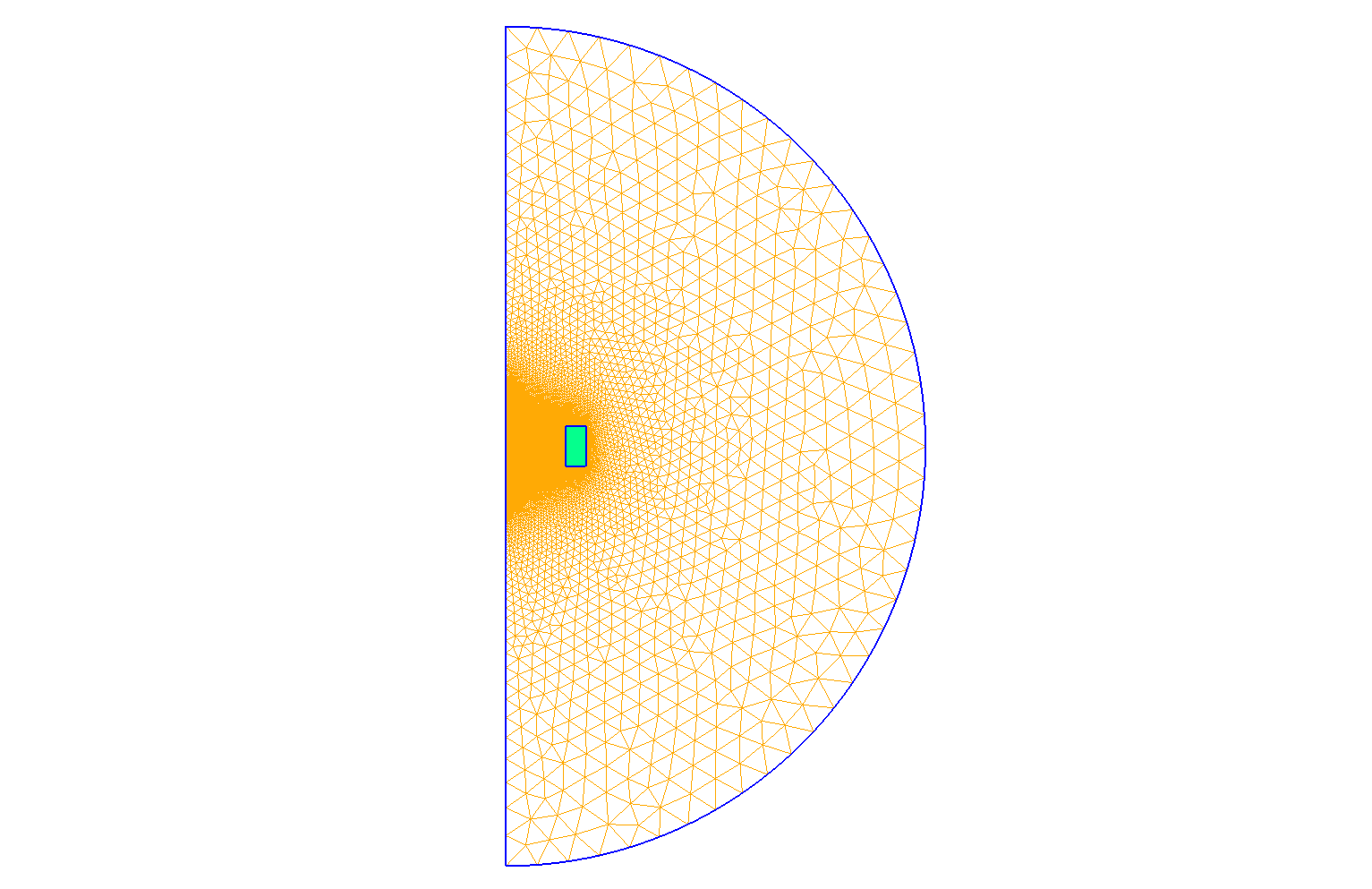
Mesh of Geometry
|
11. Result
11.1. Displacements
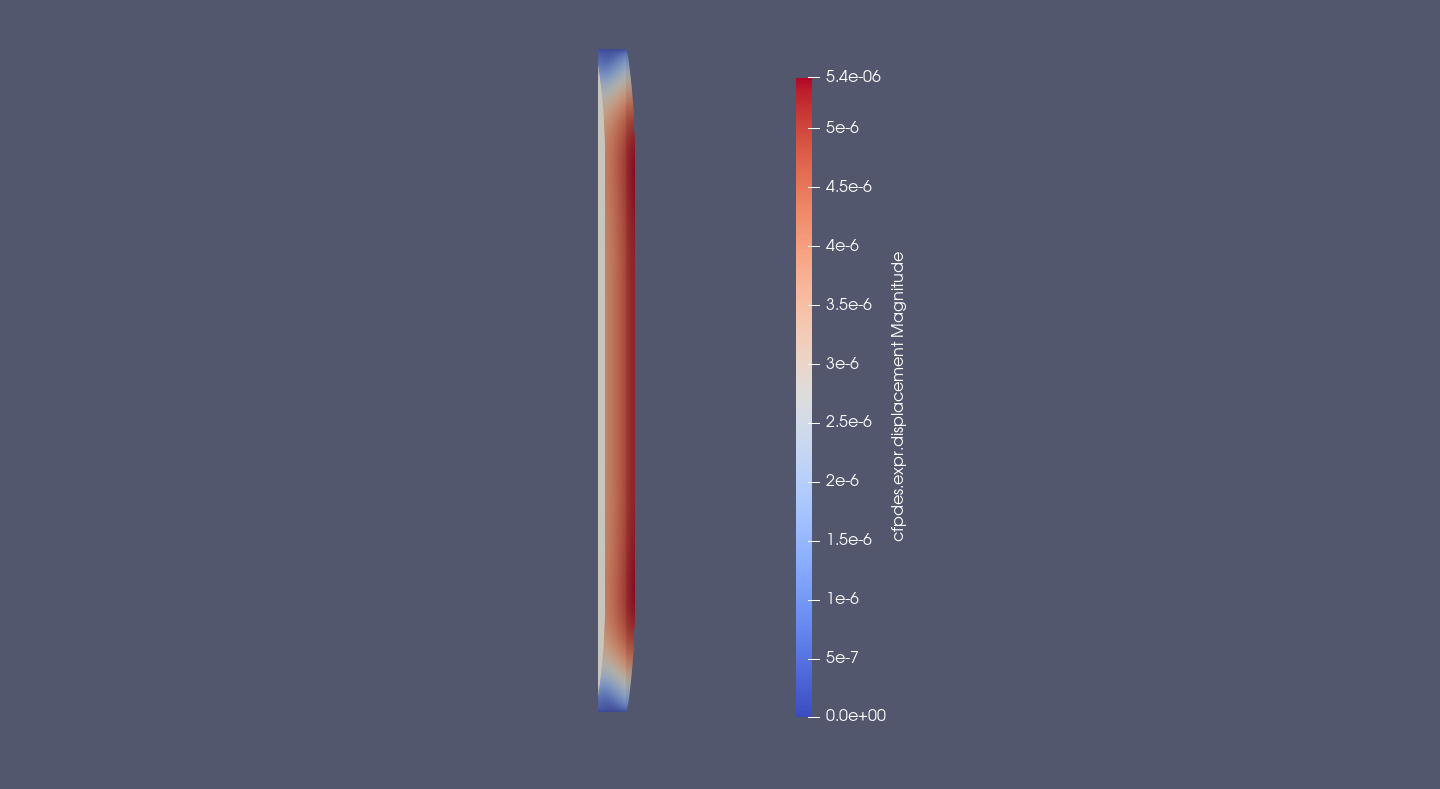
Deformation due to Thermal Dilatation Force : The white solid is initial geometry and the coloured solid is the final geometry (the colours represent Magnitude of displacement \(u (m)\))
|
The Thermal Dilatation deform the cylinder like a barrel filled with water. The cylinder deforms outwards.
We can note that near of embeded (Upper and Bottom), the cylinder deforms inwards.
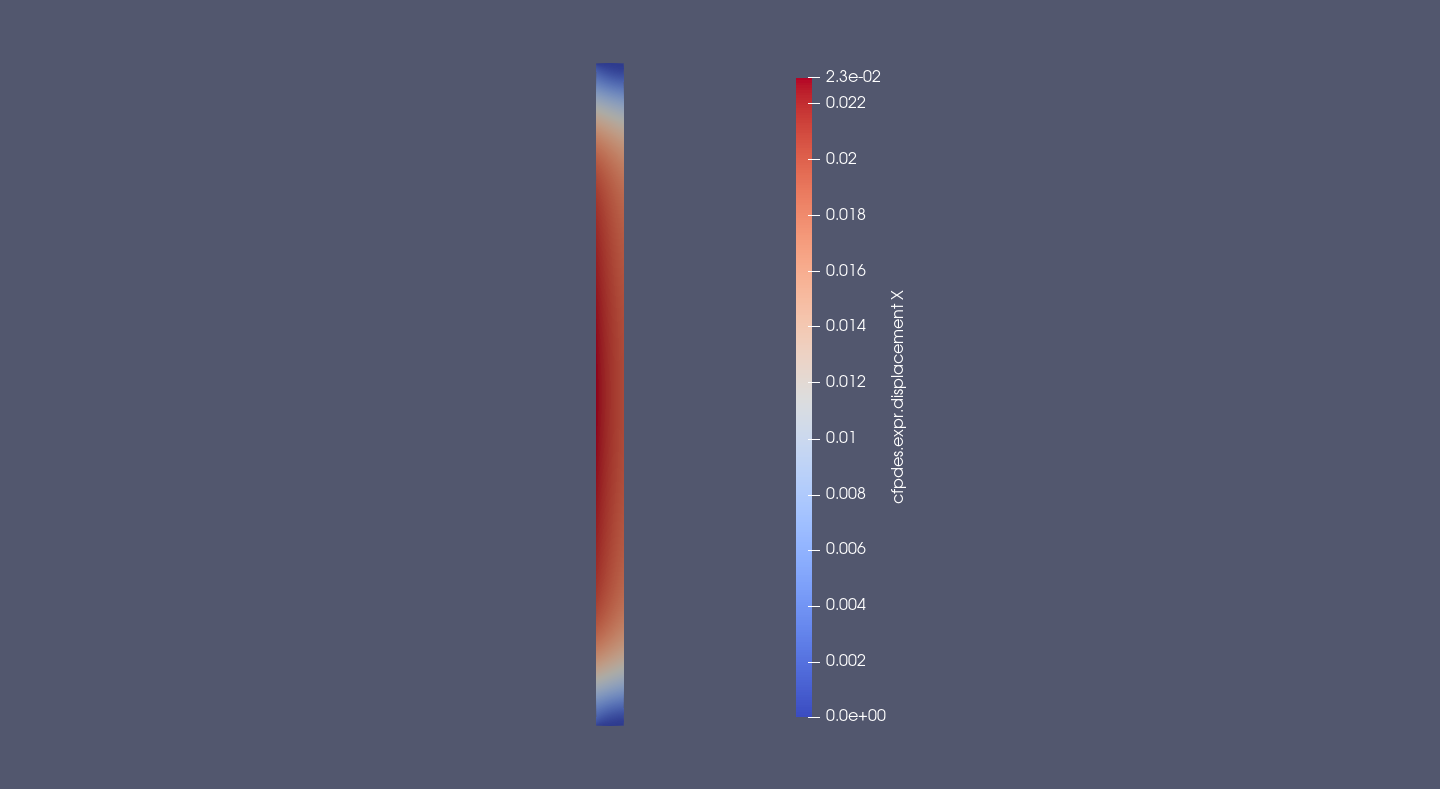
\(u_r(m)\)
|
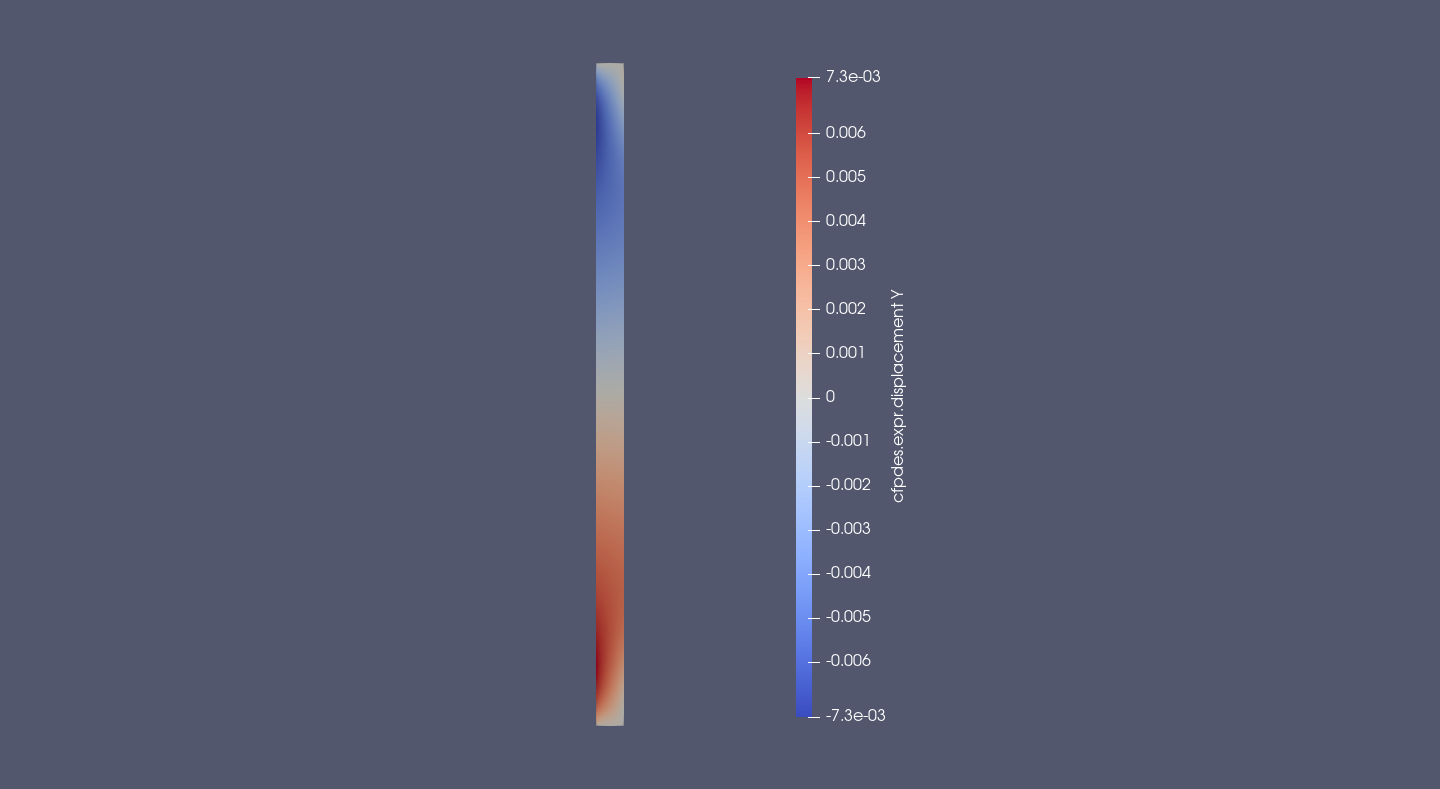
\(u_z(m)\)
|
The radial displacement \(u_r\) is maximum on Or axis near of the interior and decreases to zeros near of the embedded (on Upper and Bottom).
The z-displacement is symmetric by Or axis. Near of the interior, it positive in bottom part and negativ to upper part, the cylinder compresses toward the Or axis in z-displacement.
11.2. Tensor of Deformation \(\bar{\bar{\epsilon}}\)
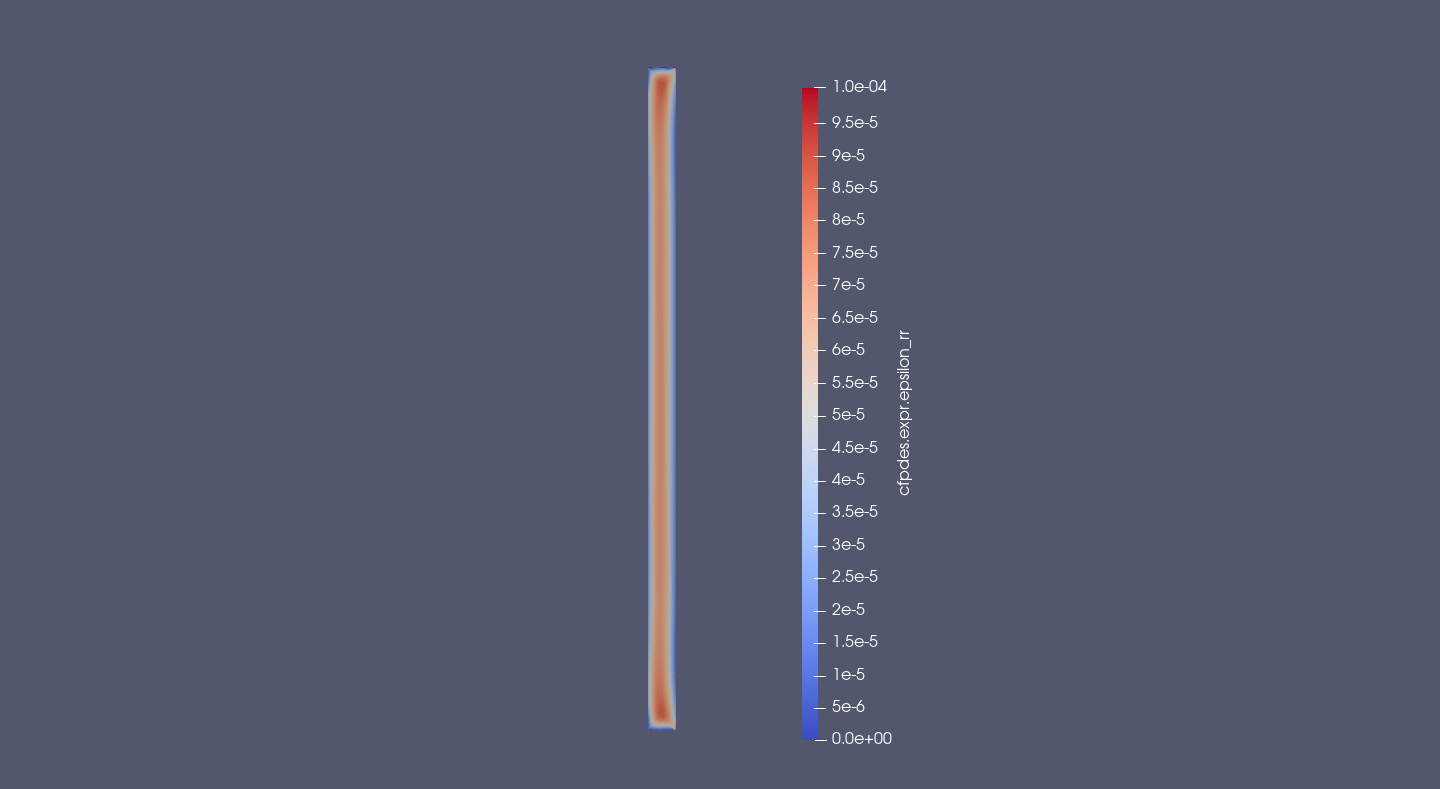
\(\bar{\bar{\epsilon}}_{rr} = \frac{\partial u_r}{\partial z}\)
|
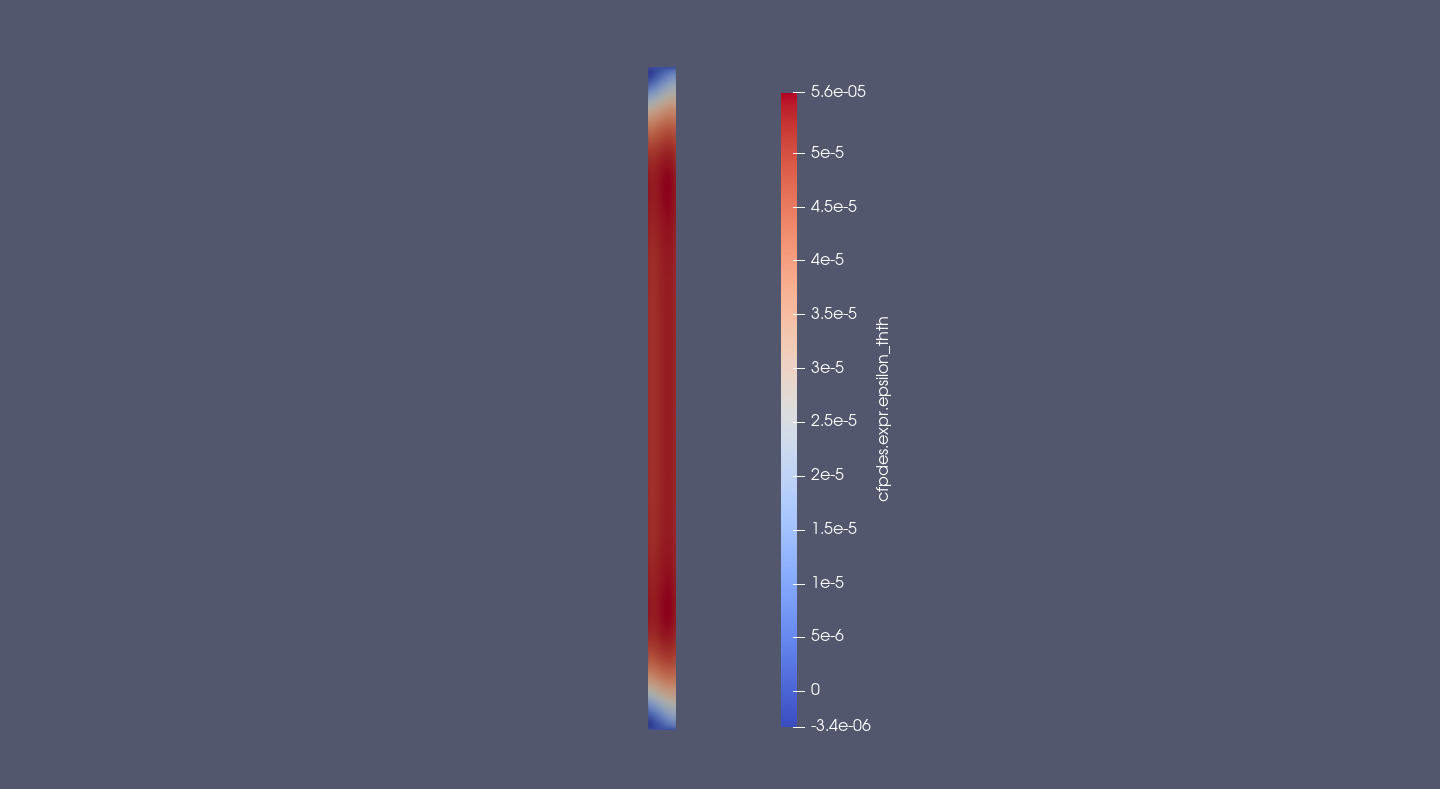
\(\bar{\bar{\epsilon}}_{\theta \theta} = \frac{1}{r} \, u_r\)
|
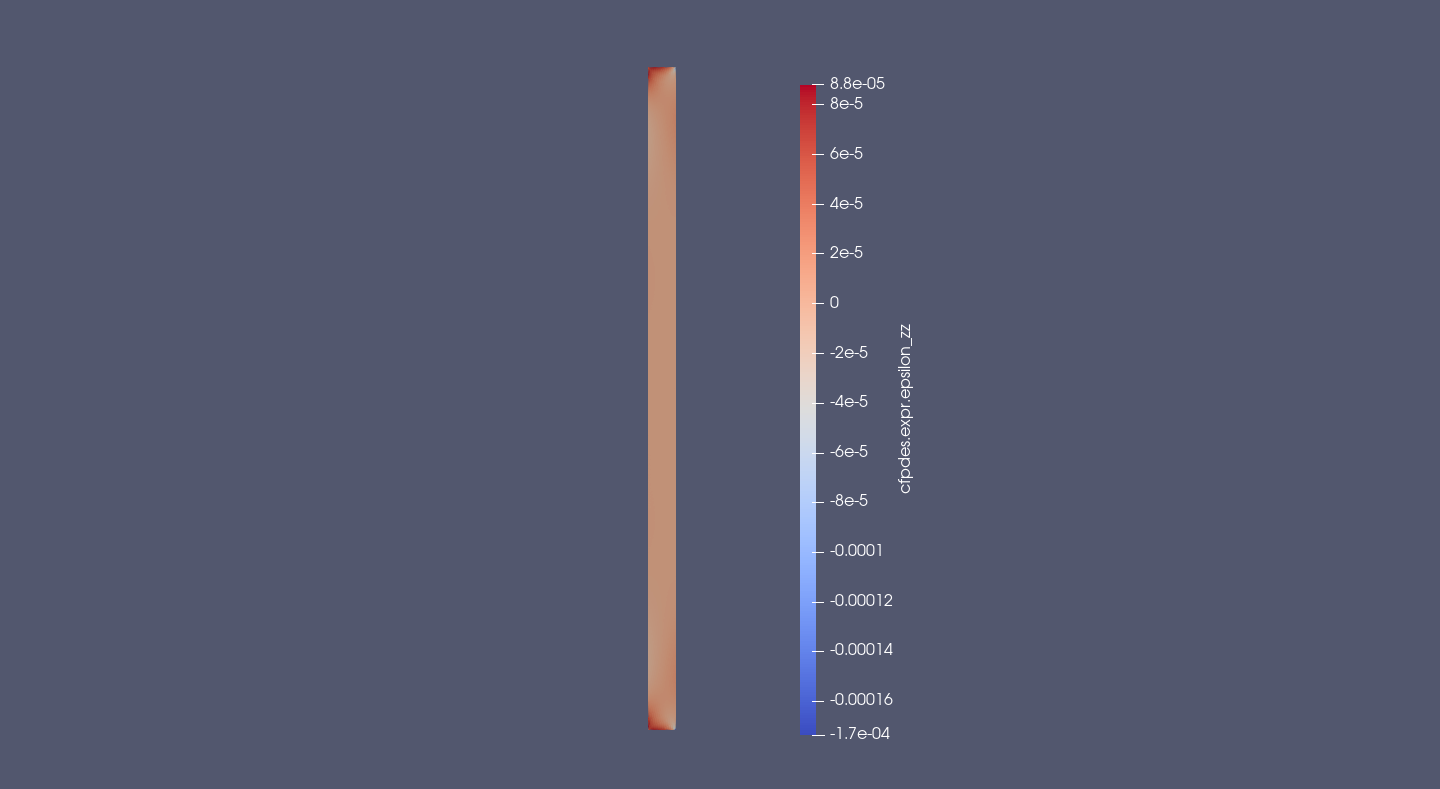
\(\bar{\bar{\epsilon}}_{zz} = \frac{\partial u_z}{\partial z}\)
|

\(\bar{\bar{\epsilon}}_{rz} = \frac{1}{2} \left( \frac{\partial u_r}{\partial z} + \frac{\partial u_z}{\partial r} \right)\)
|
The radial deformation is uniform by z. It maximum on middle radius (\(\frac{r_{int}+r_{ext}}{2} \approx 87 mm\))
The orthoradial deformation is the greatest contribution of deformation. It maximum in Or axis near of the interior and decrease to negative value near of embedding (Upper and Bottom).
The z-deformation near of the center is symetric by Oz axis. The cylinder compresses near of the interior and it expands near of the exterior.
The rz-shear is great around the embededding and null in the rest of cylinder.
11.3. Stress Tensor \(\bar{\bar{\sigma}}\)

\(\scriptsize{\bar{\bar{\sigma}}_{rr} = \frac{\lambda}{r} \, u_r + \left( \lambda + 2\mu \right) \, \frac{\partial u_r}{\partial r} + \lambda \, \frac{\partial u_z}{\partial z} - (3\lambda + 2\mu) \, \alpha_T \, \left(T-T_0\right) (Pa)}\)
|
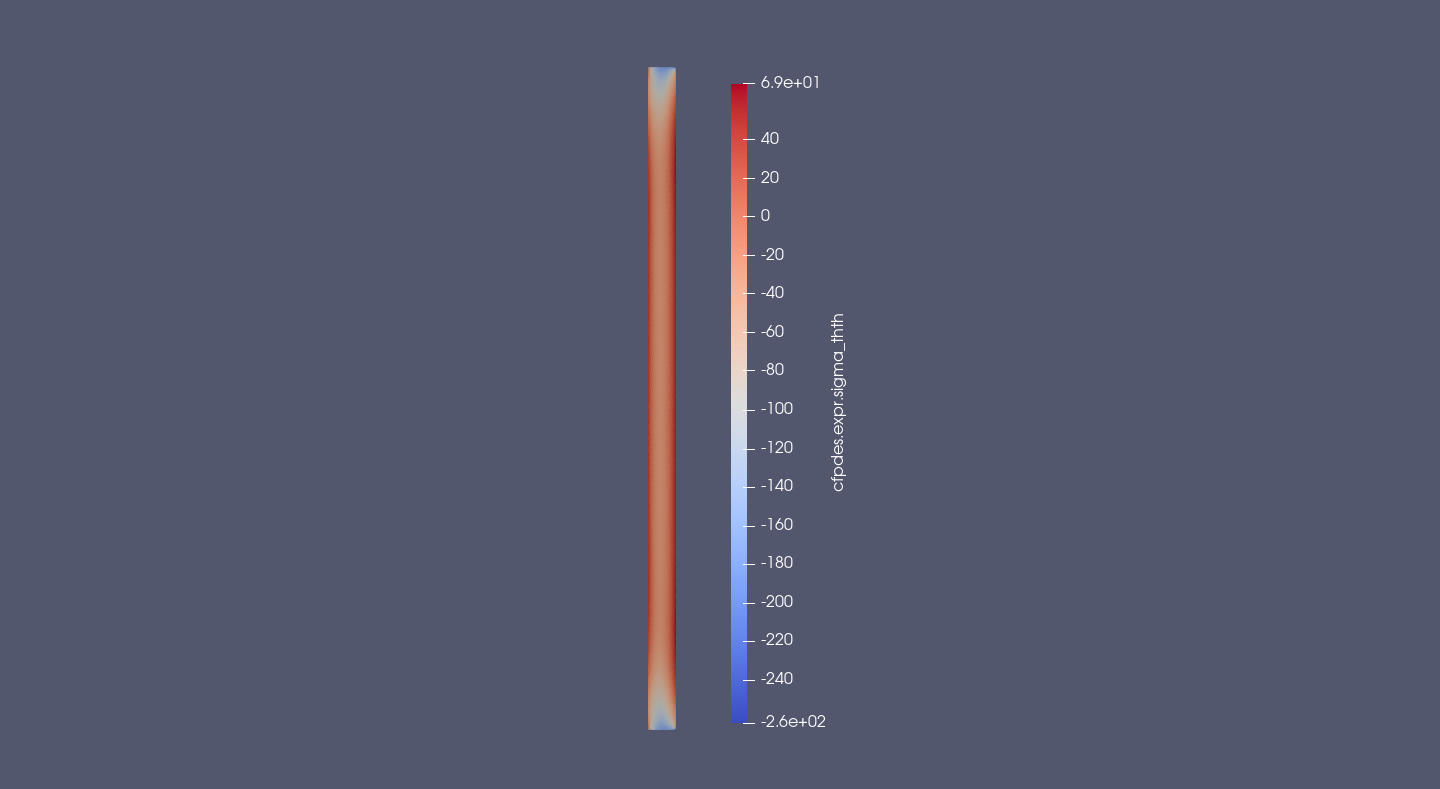
\(\scriptsize{\bar{\bar{\sigma}}_{\theta \theta} = \frac{\lambda + 2\mu}{r} \, u_r + \lambda \, \frac{\partial u_r}{\partial r} + \lambda \, \frac{\partial u_z}{\partial z}- (3\lambda + 2\mu) \, \alpha_T \, \left(T-T_0\right) (Pa)}\)
|
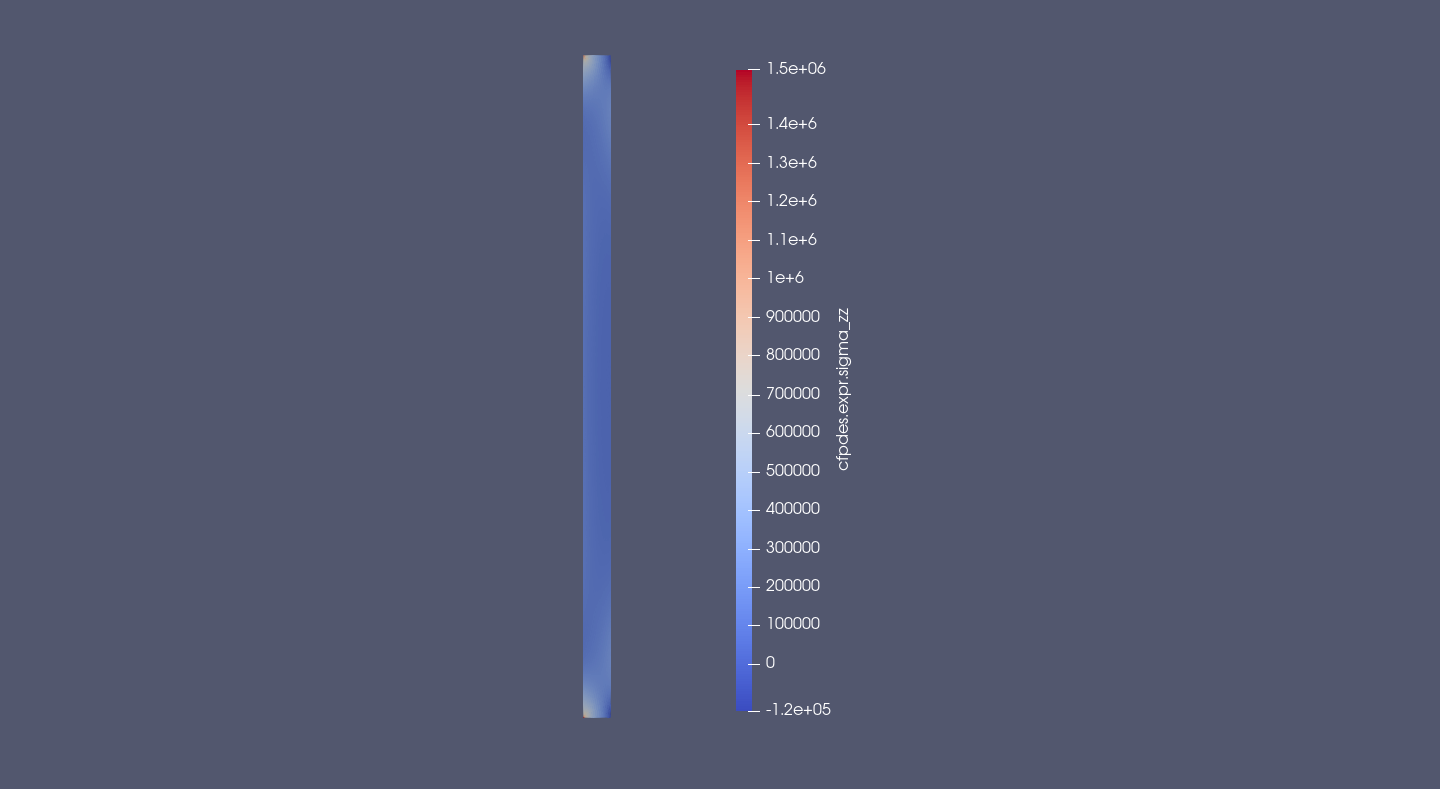
\(\scriptsize{\bar{\bar{\sigma}}_{zz} = \frac{\lambda}{r} \, u_r + \lambda \, \frac{\partial u_r}{\partial r} + \left( \lambda + 2\mu \right) \, \frac{\partial u_z}{\partial z} - (3\lambda + 2\mu) \, \alpha_T \, \left( T-T_0 \right) (Pa)}\)
|

\(\bar{\bar{\sigma}}_{rz} = \mu \, \left( \frac{\partial u_r}{\partial z} + \frac{\partial u_z}{\partial r} \right) (Pa)\)
|
The radial stress is uniform by the Oz axis and have a form. The minimum is reached around the middle.
The orthoradial stress is the greatest contribution of deformation. The orthoradial stress is uniform by the Oz axis and have a form of an upturned bell. The minimum is reached around the middle.
The z-deformation near of the center is symetric by Oz axis. The cylinder compresses near of the interior and it expands near of the exterior.
The rz-shear is great around the embededding and null in the rest of cylinder.
11.4. Other Tensor
11.4.1. Criterion of Von Mises \(\bar{\bar{\sigma}}_{vm}\)
The tensor of Von Mises permits to say if the matters is in elastic state or not. If the tensor exceeds an matter’s parameter, the matter pass to elastic state to plastic state.
The \(\sigma_i\) are the principles tensors, the eigenvalues of stress tensor \(\bar{\bar{\sigma}}\).
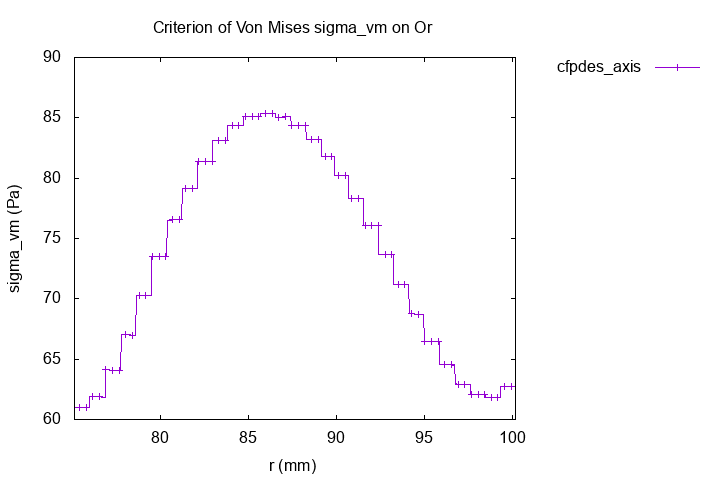
\(\bar{\bar{\sigma}}_{vm} (Pa)\)
|

\(\bar{\bar{\sigma}}_{vm} (Pa)\)
|
11.4.2. Criterion of Tresca \(\bar{\bar{\sigma}}_{tr}\)
The tensor of Tresca permits to say if the matters is in elastic state or not. If the tensor exceeds an matter’s parameter, the matter pass to elastic state to plastic state.
The \(\sigma_i\) are the principles tensors, the eigenvalues of stress tensor \(\bar{\bar{\sigma}}\).
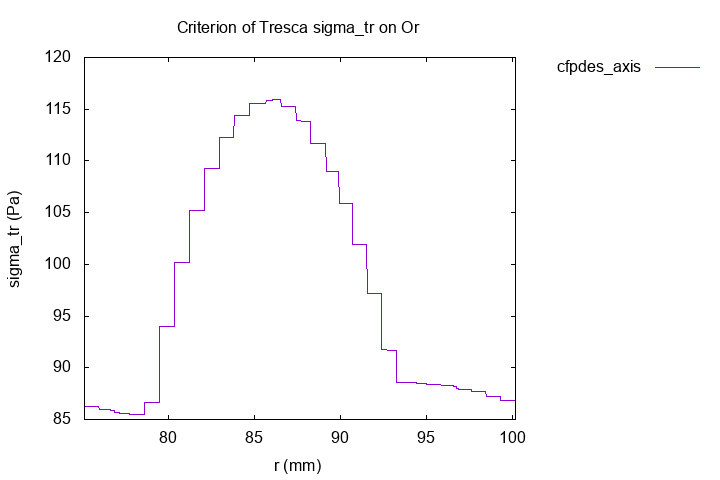
\(\bar{\bar{\sigma}}_{tr} (Pa)\)
|
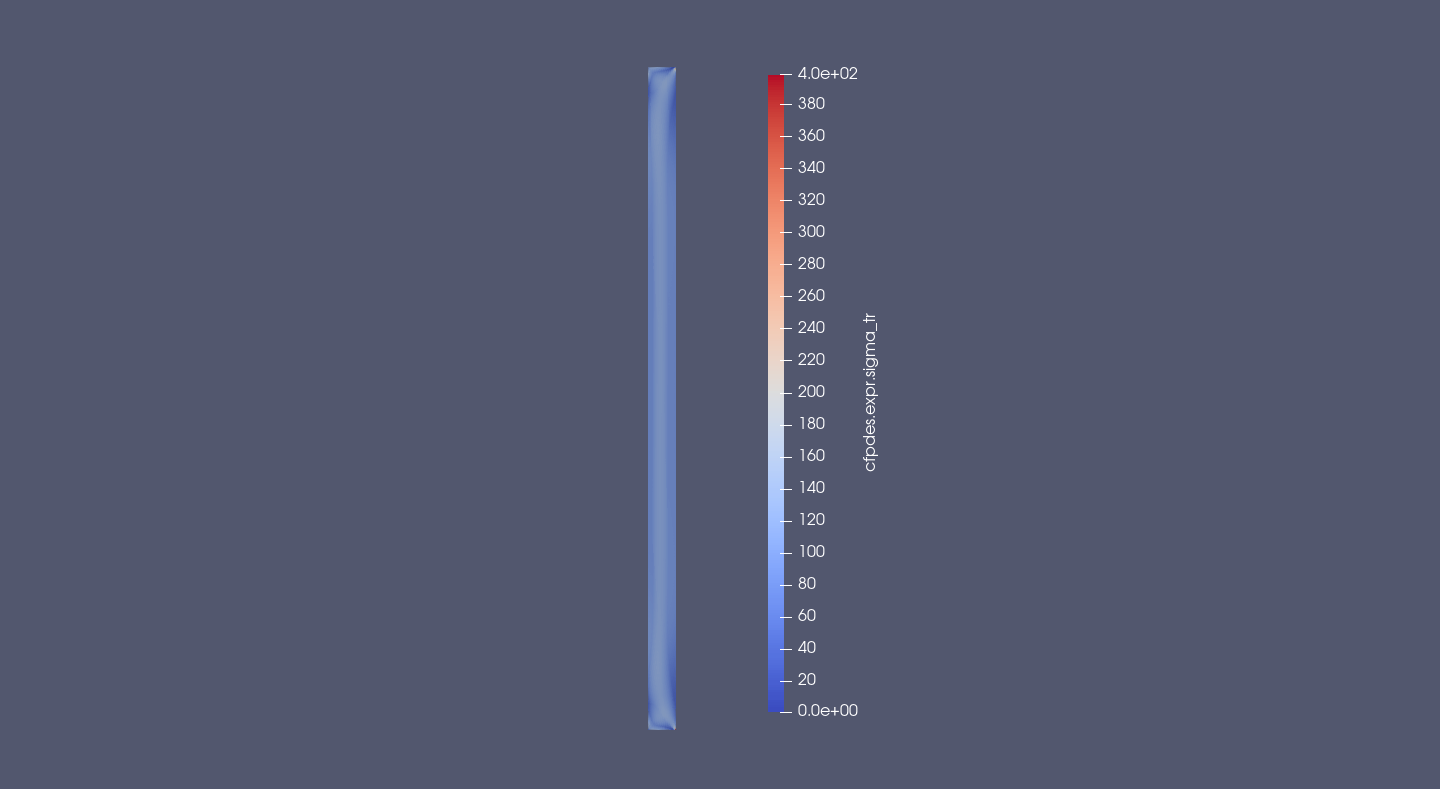
\(\bar{\bar{\sigma}}_{tr} (Pa)\)
|